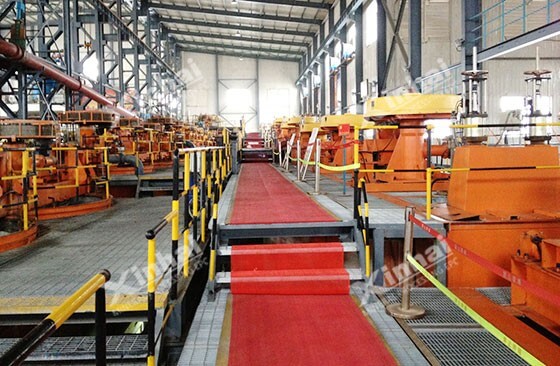

Warm Tip: If you want to know more details about equipment, solutions, etc, please click the button below for free consultation, or leave your requirements!
In generally, the copper ore is divided into three classifications: copper sulfide ore, copper oxide ore and natural copper ore.Due to the different copper ore properties, the processes used in the extraction of copper need to be tailored.
According to the different physical and chemical properties of copper ore, a single or several joint separation processes are used to separate useful copper minerals and gangue minerals after crushing and grinding. Here you'll learn more details about mineral separation process for oxide copper ore and sulfide copper ore.

The massive sulfide ore is crushed to 12cm by jaw crusher or cone crusher. This process may adopt multiple crushing stages by combining with the vibrating screen.
The qualified crushing materials are sent to the grinding mill through belt conveyor and feeder. The material, water and steel balls in the grinding mill hit with each other, which further reduced the ore particles, and the particle size of copper ore is decreased to 0.2-0.15cm finally.
The copper extraction stage is the key stage to improve the grade of copper ore. The pulp discharged from the grinding mill is transported to the agitation tank, where the flotation reagent is added in rouging flotation stage. After full agitation and activation of the agitation tank, the pulp is fed to the flotation machine.
Adding the collectors, regulators and foaming agents during the froth flotation process, the useful minerals are concentrated in the froth, which is scraped by the scraper of the flotation machine and sent to the dewatering machine.
The enriched pulp obtained by the froth flotation is sent for mechanical dewatering, and then transported to the smelter for smelting. Finally, the grade of copper metal is up to 99.0%-99.7%.
There are two kinds of common processes used in the extraction of copper oxide ore: froth flotation process and leaching process.
Same as the method used in the extraction of copper sulfide ore.
The froth flotation process is also suitable for the copper oxide ore, the difference of both lies in the flotation reagents. According to the flotation reagents, there are five common froth flotation processes: sulphide flotation process, fatty acid flotation process, amine flotation process, emulsion flotation process and chelate-neutral oil flotation process.
Same as the method used in the extraction of copper sulfide ore.
The common leaching processes used in the extraction of copper oxide ore include heap leaching, pool leaching, in-situ leaching and agitation leaching.
The mined ore is crushed to a certain size by the crusher. Because the leaching stage does not need to reach the same small particle size as the froth flotation process, the heap leaching process does not need grinding stage, the ore can be directly sent to heap leaching after crushing. The oxide ore (mix with partial sulfide ore) is placed on a leaching pad and sprayed with the strong acid solution to permeate the crushed ore. As time goes on, the copper in the crushed ore is leached into the solution as the pregnant solution, and then pumped to solvent extraction equipment for further purification.

The pool leaching process is a common leaching method used in early wet copper smelting. Using the strong sulfuric acid solution to leach the 1-2% copper-contained oxidized ore (particle size is-1cm). Because the concentration of copper in the leach solution is high, it can be directly used for the copper electrode position.
During in-situ leaching, the well spacing is generally 30x30cm (or 15×7.5m), and the diameter of the borehole is 15-25cm. Plastic pipe is set in the hole through the ore body, and the leaching agent flows into the ore body along the plastic pipe, the leaching solution is pumped back to the ground from the bottom of the ore body.
In-situ leaching process can be used to treat the residual ore of old mines or the unmined oxidized copper ore and lean copper ore. In-situ leaching process has better potential than other processes for those abandoned mines or uneconomical copper mines with other processes.
Agitation is carried out in the leaching tank equipped in the agitation leaching device. The fine grains (-75um accounts for 90%) oxidized ore or calcined sulfide ore are leached by high concentrated sulfuric acid solution. There are two ways of leaching: air agitation and mechanical agitation.
Because of small particle size and enough agitation, agitation leaching process has faster leaching speed and higher recovery rate than pool leaching process. Therefore, agitation leaching process can treat high-graded ore or the ore with lower-graded tailings (Cu<1%).
All in all, the processes used in the extraction of copper are often determined by the copper ore natures, mineral processing conditions, investment budget and other factors. It is suggested that the miner should learn about the copper ore properties, and then select the single or combined copper extraction processes by the mineral processing test.
Last: 5 Performance Parameters Affect Efficiency of Vibrating Screen
1What Are the Processes and Equipment Used in the Copper Mining Process?

 4918
4918


What Are the Differences Between CIP and CIL?
 11454
11454
 0
0